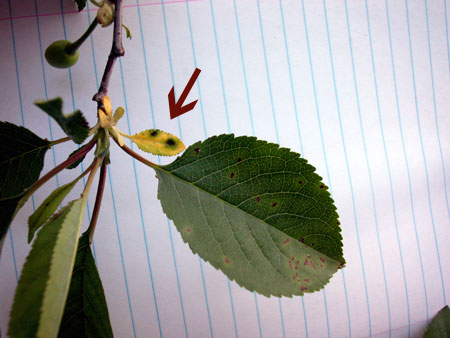Cherry leaf spot symptoms already observed in low crop orchards
Control strategies for orchards with cherry leaf spot symptoms early in the season and a light crop.
If the devastating spring weather was not the only problem in tart cherry orchards, we have already observed cherry leaf spot symptoms showing up across the state. We suspect that these early symptoms are a result of the rainy weather two weeks ago coupled with half-side fungicide applications or stretching the intervals in a year with a light to nonexistent crop load. Cherry leaf spot symptoms at this time of the season are a cause for major concern, particularly as we recommend that trees keep their leaves until mid-September. The occurrence of symptoms in orchards right now indicates that leaf spot will be exceedingly difficult to control this year.
At the start of infection, leaf spot can be difficult to see on the leaves. The typical symptoms of cherry leaf spot are small (1 to 3 mm), red to purple spots on the upper leaf surface (looking at leaves with back-lighting is helpful) and there is often a visible dot of white spore growth in the middle of the lesion. These spore masses are a sign of the pathogen and serve as inoculum for new infections. Eventually, the lesions will turn brown and fall out of the leaf. In heavy infections, spots can coalesce and produce larger areas of dead leaf tissue. With a lot of bacterial canker visible in orchards, growers should look for the growth of white spores to identify leaf spot as well as smaller purple lesions. Bacterial canker symptoms on the leaves are dark brown, circular to angular and often have a yellow halo; canker lesions are also larger in size than leaf spot lesions. Leaves that are accumulating lesions will soon begin to turn yellow and drop prematurely from the tree. Early defoliation will increase the potential for tree mortality in a hard winter.
Cherry leaf spot is usually effectively controlled early in the season with proper fungicide application timing. In years with extended dry weather, leaf spot symptoms are not visible in most orchards until August-September. However, in years when we receive significant rainfall early in the season with extended wetting periods, early infections of leaf spot can occur. These early season infections begin on bract leaves (Photo 1) and spread throughout the canopy from these small leaves. Growers should be scouting their orchards for such infections now. If leaf spot symptoms are evident, they are an indication that spore loads in orchards will soon be very high and difficult to control through September.

Photo 1.
Early season cherry leaf spot infection on bract leaf (red arrow)
of
Montmorency tart cherry.
If cherry leaf spot symptoms are present in the orchard this early in the season, tart cherry leaves will need effective fungicide protection from now until after the traditional harvest timing. Because of the potential high disease pressure with symptoms so early in the season, we recommend growers use the maximum label rates of fungicides and cover entire orchard blocks (i.e., do not use an alternate middle row spray plan). If cherry leaf spot symptoms are present, full cover sprays are needed to minimize the impacts of this fungal disease by reducing the potential of a cherry leaf spot epidemic this season.
If cherry leaf spot infection is observed in a block, growers should apply a full cover of chlorothalonil (Bravo or generic brands) in orchards that will not be harvested as this material is highly effective against cherry leaf spot. If the orchard will be harvested, we recommend using the new 24(c) label for Bravo Weather Stik – again, chlorothalonil is rated excellent against cherry leaf spot. The extended label is for Bravo Weather Stik only. However, a chlorothalonil application will not eliminate the current infection, and the intent of this spray is to protect tissue from the onset of spores from the existing infections.
As we no longer have materials that will “burn out” cherry leaf spot, this protectant strategy will need to be used season-long. Syllit (or dodine) used to have some eradicant activity, and although it is an excellent cherry leaf spot material, we are unsure of its current abilities to stop a cherry leaf spot infection. Copper has also exhibited some post-infection activity, but again, this material cannot be relied on to eradicate a cherry leaf spot infection.
Leaves currently exhibiting a number of lesions at this time are almost sure to defoliate, and the goal of this season’s management plan is to limit the amount of infection of currently healthy foliage through protection against subsequent infections. The cherry leaf spot spore load will probably be high in most orchards for the remainder of the season, and these blocks must be intensively managed for the next several months to minimize impacts on overall orchard health. Even in a year without a crop, it is important to keep the trees healthy for 2013.
Dr. Sundin’s work is funded in part by MSU’s AgBioResearch.



 Print
Print Email
Email

